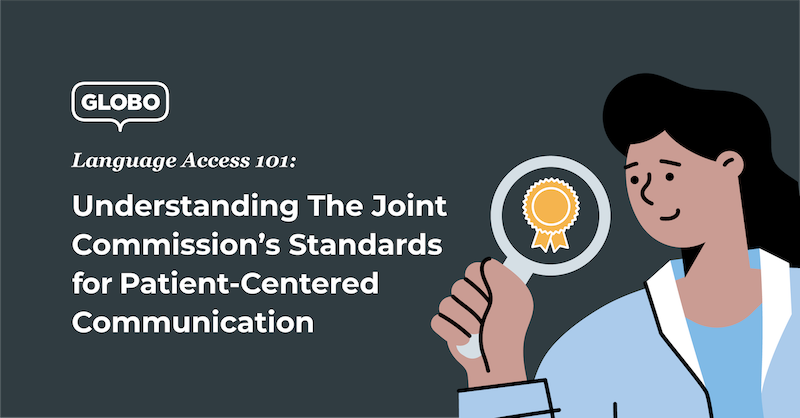Stay up to date.
Stay connected with tips, resources & stories on language access.

The Joint Commission is considered the gold standard of accreditations. Whether you serve a limited-English proficiency (LEP) population or some of your patients are deaf or hard of hearing, The Joint Commission has created guidelines to help foster patient-centered communication.
If your healthcare system is seeking accreditation or expecting a review, there are three key areas to pay attention to when looking to ensure adequate and effective patient-centered communication.
The Joint Commission's emergency management standards do not specifically address the issue of communication in emergency situations. However, its Advancing Effective Communication: A Roadmap for Hospitals document makes it clear that the diversity of communities served by hospitals must be taken into account when planning for emergencies and ensuring patient safety. For example, directions for a decontamination shower should be accompanied by posters giving visual instructions. The Roadmap also notes that those with limited-English proficiency should be considered a vulnerable population when planning for a potential surge in vulnerable patients.
Throughout your emergency planning, think about how emergency instructions could be communicated to your LEP patients, as well as those who have limited eyesight or hearing. You don't necessarily need to have every piece of documentation translated ahead of time. Still, you need to ensure that all patients receive clear directions during any emergency situation, whether through visual cues or on-demand interpretation.
In the Roadmap, The Joint Commission notes that hospitals exist to serve the patient populations of their local communities. Its leadership standards focus on the top-down nature of providing excellent patient care, recognizing that the organization's culture, systems, and resources are vital to successfully completing its mission. Many of the leadership standards address communication.
To ensure that all patients have equal access to healthcare through effective communication, it is crucial for healthcare systems to provide language solutions as needed for their patients with limited-English proficiency. According to research, hospitals without adequate language solutions place patients at risk for unnecessary tests and readmissions. In addition, bringing patients and families into the healthcare conversation can improve quality of care, safety, and satisfaction, while lowering costs.
The guidelines for provision of care, treatment, and services (PC guidelines) are designed to bring together the complex processes of providing patient care in a collaborative and cohesive manner. PC.02.01.21 focuses specifically on the communication between patients and their providers. It requires healthcare providers to identify each patient's communication needs, from interpreters to reading glasses, and to always communicate in a way that meets those identified needs.
The Roadmap notes that it is not necessary to translate every written document in advance to every conceivable language, but instead to provide alternative means of communicating information when written documents are not available in the patient's primary language. For example, you might provide on-demand translation services or have the information provided orally by an interpreter certified in the patient's preferred language. If someone wears glasses, they should be easily accessible when you present the patient with a written document or form.
The Roadmap also points out that communication needs can change throughout a patient's visit. For example, someone might be fluent in conversational English but need to switch to their primary language when discussing complex medical treatment options or needing to understand medical terminology.
It's always easier to follow guidelines and meet standards when you understand what they are trying to accomplish. Patient-centered communication is a natural outgrowth of patient-centered care. Rather than following the older model in which doctors were in charge, and patients were expected to simply comply, patient-centered care is guided by the patient's values, needs, and preferences.
Patient-centered care recognizes that health is personal and that providers who offer clear communication and empathy get better outcomes. Patients are assumed to have the right to make their own healthcare decisions, and providers have the responsibility to provide all needed information and answer all questions to help them reach the best decisions.
However, this model can break down when patients have limited English skills (or have sight or hearing impairments that prevent them from taking in all offered information). Patients are in charge of making their own healthcare decisions, but they don't necessarily have all the tools to do so. And even when they can figure out what's going on and make a decision, they may not be able to fully communicate their needs and desires. These communication barriers can lead to misdiagnoses, unneeded tests, and poorer healthcare outcomes.
Patient-centered communication ensures they're on equal footing. With strong language solutions, including on-demand interpretation and translation services, you can have the same discussions regarding diagnoses, treatment options, overall healthcare goals, and other topics with your limited-English proficiency patients as you do with everyone else. You won't need to worry about valuable information getting lost or filtering communications through a family member or friend who is untrained in interpretation.
You will be able to focus on what you do best — providing professional, empathetic, caring healthcare services. Meanwhile, you can feel confident that everything you and your patient say to each other is accurately communicated and that all written information is presented in a way that the patient can understand. It's a win-win for both you and your patients.
Every patient has unique needs, one of the most critical being communication. The Joint Commission provides detailed guidance on how hospitals and health systems can meet the needs of every patient who walks through the door. Improving language access and health equity for your limited-English proficient and deaf or hard of hearing patients can ultimately improve patient flow, satisfaction, and reduce unnecessary readmissions.
Want more insight into meeting patient-centered communication standards? Watch our webinar with The Joint Commission's Dr. Christina Cordero to learn more about how you can implement patient-centered communication in your health system.